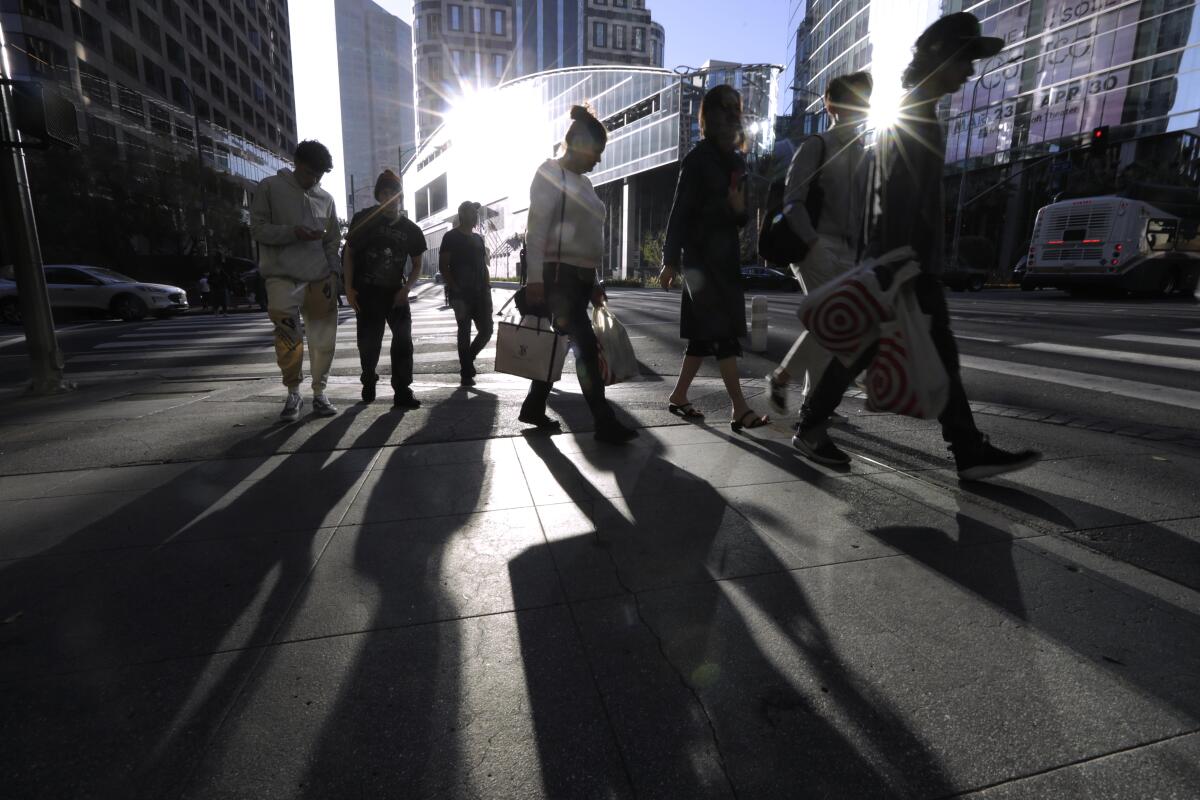Downtown L.A.’s ‘zombies’: How to fight a post-COVID plague of undead office buildings

- Share via
The pandemic-driven shift to remote and hybrid work has decreased demand for office space and will steadily lower its value. That has huge implications not just for building owners but also for cities that rely on property tax revenue and the economic vibrancy that office workers generate.
A recent Boston Consulting Group survey found that many office buildings are at risk of becoming “zombies,” with low usage, high vacancy and quickly diminishing financial viability. The problem is particularly acute in Los Angeles and San Francisco, where weekday office building use has fallen to around 40%. As a result, in both cities, public transit revenue has plummeted by 80% or more, and office property values and tax revenues may drop by as much as half, according to our analysis of public data.
Rising interest rates are compounding the financial pressure for building owners, whose rental income stands to drop 35% to 45% as corporate leases expire in both San Francisco and Los Angeles. Higher borrowing costs coupled with lower valuations could leave some owners owing more than their buildings are worth, leading in turn to a wave of defaults that suddenly make lenders the owners and managers of these buildings. In February, a fund managed by Brookfield Properties defaulted on $784 million in loans on two well-known office skyscrapers in downtown L.A., which was seen by some as a turning point for the U.S. office market.
We define zombie buildings as those that are at least half-empty. Many buildings are already at that mark, and 60% of office leases nationwide are set to expire over the next three years.
A vicious circle is emerging: Lower office building use leads to less spending at surrounding businesses and, as leases turn over, less rent revenue. This leaves less money available for building improvements, which further decreases property values and resources for maintenance and upgrades. As vacancies persist, businesses that cater to office workers close or relocate, creating more vacancies and often causing public-safety problems that cities struggle to address with diminished tax revenues.
Dealing with these new workplace and financial realities will require property owners, city leaders and lenders to take action to break the cycle and reimagine downtowns.
Cities need to take several steps over the next few years to revitalize downtown areas and reinvent or enhance them as destinations for living, working and playing:
- Establish a baseline: Cities should assess office buildings for their likelihood of low occupancy and default and estimate the resulting budget shortfalls from lower tax revenue.
- Encourage use: Cities should evaluate land-use rules to ensure that they don’t impede downtown revitalization; invest in public spaces and keep them safe, with a special focus on transit; and encourage government workers to return to office buildings to boost the vitality of downtown corridors.
- Support new uses: Zoning and development regulations should be revised to allow for more downtown housing, hotels and retail and office space. Incentives such as tax breaks and subsidies can boost conversions to residential use, affordable housing and energy-efficient retrofits.
- Replace lost revenue: City leaders can delay property reappraisals; make better use of public spaces for art, music and theater programming to draw people downtown to spend time and money; and find new sources of revenue such as tourism and arts and culture districts.
Property owners, for their part, need to evaluate their commercial real estate portfolios and decide how to revive or relinquish zombie buildings based on their characteristics, neighborhoods, markets, finances, and city taxes and incentives.
Commercial office properties will fall into one of five categories: continued high occupancy and profitability; viable as office space with a moderate decline in income; appropriate for conversion to housing, hotel or other uses; suitable for redevelopment with public support; or unsuitable for reuse or subsidized redevelopment and therefore subject to default.
Making these decisions will be difficult but necessary. The pandemic created a permanent change in workplace behavior, so even a national economic rebound or a pause in interest rate hikes will not solve the problem for many buildings. Our analysis suggests that a third or more of current U.S. office space won’t be needed.
Lenders, meanwhile, should work closely with property owners and city governments to try to prevent a wave of building defaults that could force them to become the owners and managers of zombie buildings, setting off a spiral of declining property values. They will need to manage risk, restructure loans near or in default and develop markets where they can sell those loans. At the same time, they’ll have to evaluate and finance reuse and redevelopment projects as downtown districts take on new functions.
The U.S. office market faces dramatic upheaval over the next three years, forcing the nation to deal with moribund office buildings in very stressed urban neighborhoods. Given the stakes, cities, owners and lenders must begin to rethink how we use commercial buildings after the pandemic and what we want downtown.
Santiago Ferrer is Boston Consulting Group’s North America lead for cities, real estate and infrastructure development.
More to Read
A cure for the common opinion
Get thought-provoking perspectives with our weekly newsletter.
You may occasionally receive promotional content from the Los Angeles Times.









